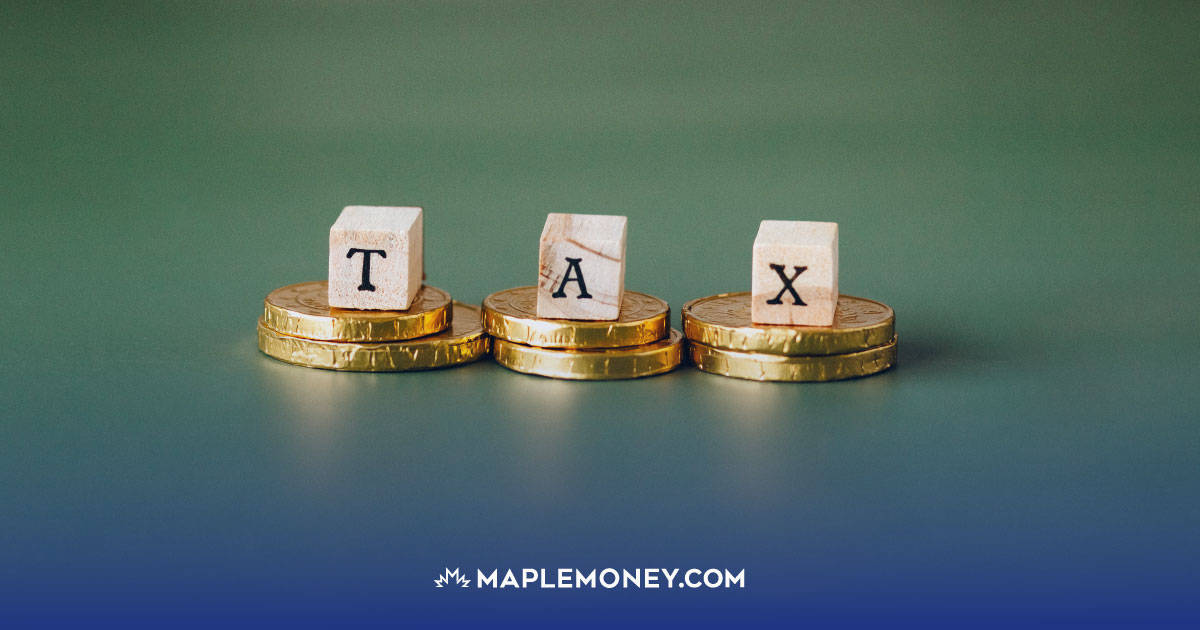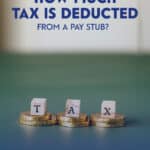How Much Tax Is Deducted from a Pay Stub?

If you’re an employee in Canada, your take-home pay is less than your gross income because of deductions. Some of the deductions, like income tax, are forwarded to the federal government and required by law. Others are related to your job.
Either way, all payroll deductions are reported on your pay stub. But what exactly is a pay stub, and how much income tax and other amounts are deducted?
What Is a Pay Stub?
A pay stub is a document given to employees every time they get paid. It includes their gross pay, a list of all deductions, and provides them with their net pay amount, which is the final amount they receive. While most companies use digital pay stubs, which employees can access online, paper-based stubs are still very common.
What Types of Deductions Are Included on a Pay Stub?
The federal government deducts federal income tax, employment insurance, and Canada Pension Plan (CPP) from your paycheck every pay period. Actually, your employer handles the deduction and forwards the money to the government. I’ll explain how the various deductions are calculated a bit later.
In addition, your employer will deduct other amounts related to your employment. While they aren’t the focus of this article, I’ve included them in the following list of common pay stub deductions:
Common Payroll Deduction Items
- Government Deductions
- Canadian income tax
- Canada Pension Plan (CPP) Contributions
- Employment Insurance (EI) Contributions
- Employer Deductions
- Pension contributions
- Union Dues
- Employee Benefits, including:
- Life insurance premiums
- Short & Long-Term disability premiums
- Health insurance premiums
- Dental Insurance
- Group retirement savings plan
- Charitable donations
You may notice other deductions than the ones I’ve included here. Remember that employer deductions vary from one company to the next.
Here’s a closer look at how the federal government’s deductions are calculated, starting with income tax.
Income Tax
Canada uses a progressive, or graduated, income tax system. That means that as your income grows, the rate at which you are taxed increases. The following federal tax rates illustrate how this works:
Income Range Federal Tax Rate for 2023
?$1 to $53,359? 15 percent
$53,359 to $106,717? 20.5 percent?
$106,717 to $165,430? 26 percent
$165,430 to $235,675? 29 percent
Over $235,675 33 percent?
Here are a couple of tax rate examples using different income amounts:
- Let’s say you have an income of $50,000. It’s simple; you’ll pay a federal income tax rate of 15%.
- If your income is $120,000, you’ll pay 15% on the first $53,359, 20.5% on the next $53,359, and 26% on income above $106,717 (approximately $13,000).
Basic Personal Amount
You don’t pay income tax on your entire income. For 2023, the first $15,000 you earn is not taxed; it’s called the Basic Personal Amount, a non-refundable tax credit for all Canadian taxpayers. It removes federal income tax from the lowest income earners. Even if you earn more, you get a partial reduction in federal income tax.
How to Reduce the Income Tax Deducted from Your Bi-Weekly Pay
The federal government uses a TD1 Personal Tax Credit Return form to determine how much tax to deduct from your gross earnings. But many Canadians have income tax deductions that are not accounted for on that form. Examples include charitable donations, RRSP contributions, childcare expenses, etc.
If these deductions result in you receiving a large income tax refund each year, it indicates that the government is deducting too much income tax at source, affecting your take-home pay.
You can request a reduction in income tax deducted from your regular pay by filling out form T1213, Request to Reduce Tax Deductions at Source.
Before filling out the form, make sure that the deductions are accurate. The last thing you want is a large bill from the CRA come tax time.
EI and CPP Deductions
In addition to income tax, your employer is required, by law, to deduct Employment Insurance and Canada Pension Plan contributions from your bi-weekly paycheque and forward the amounts to the Canada Revenue Agency (CRA). Most Canadians will benefit from EI or CPP at some point. Here’s some background on each of these pay stub deductions.
How Employment Insurance Deductions Work
Employment Insurance (EI) is a federal government program providing temporary income for unemployed Canadians while they search for a new job or upgrade their skills. The program is funded by employee and employer contributions, and EI contributions are among the many payroll deductions reflected on your pay stub each pay period.
Canadian employers must deduct employment insurance premiums from every dollar of their employee’s insurable earnings up to a specified limit. For 2023, the maximum deduction is $1,002.45, based on maximum insurable earnings of $61,500, 0r 1.63%. There are no EI deductions on income above the maximum. In addition, the employer must contribute 1.40% of the employee deduction, up to a maximum of $1,403.43. Different rates apply to workers in the Province of Quebec.
How Canada Pension Plan (CPP) Deductions Work
The Canada Pension Plan is a government pension plan designed to provide Canadian workers with a guaranteed income upon retirement. To receive CPP, you must be 60 or over and have made at least one valid contribution to the CPP during your working years. Like Employment Insurance, CPP is funded by employee and employer contributions. The more you contribute, the higher your monthly CPP benefit will be.
CPP deductions occur up to the maximum annual pensionable earnings amount, which for 2023 is $66,600. Because there is a basic exemption on the first $3,500 of earnings, the maximum contributory earnings is $63,100.
As an employee, the maximum annual contribution is $3,754.45, a rate of 5.95%. This amount will appear next to the tax deductions on your pay stub, and employers must also contribute an equal amount.
The Bottom Line on Canadian Payroll Deductions
Remember that your annual salary represents your gross income and doesn’t account for income tax (including provincial tax), EI, or CPP deductions. Use your pay stub to determine your actual take-home pay and create a budget based on that amount. You should also check your pay stub to ensure there are no errors and that you receive your full payment.


Comments
Thanks for the great summary! I’m happy to pay my share of taxes, but something that has always bothered me is how government deductions are not the same amount all year. For example, EI gets deducted at a high rate starting in January until you reach the maximum contribution, then take-home pay goes up again.
In total, my pay differs almost $600 per month at different times of year! This makes budgeting very challenging.
Do we have any say in this? I’ve asked our payroll office and they said it’s a government rule. Any idea why they do this? Is anyone else as annoyed by this as I am?